From the moment we pulled out of the airport in our rickety tuk-tuk and into the hot, acrid dust of Siem Reap, it was apparent that this country has experienced hardship. Thailand is still developing but boasts thriving city centres serving as economic hubs. Cambodia doesn’t have much. Were it not for its relics of ancient cities, I’m not sure Cambodia on its own would incite much tourism. But as it stands, Cambodia is still growing and rebuilding; numerous luxury hotels and resorts have popped up, acting as flagrant displays of the excess of Western culture in a country that just 40 years ago was pilfered to the bone.
Step just outside the gates of these airconditioned safe havens and you will see the true face of the country. Motorcycles look overused and shoddy, markets are dirty and empty, homes have fallen into disrepair. There is garbage everywhere, everywhere, everywhere! Heaping piles of bags of rotting vegetables block the sidewalks and spill into the street. Overgrown fences are strewn with wrappers and plastic and bottles wedged between the lattice. Ponds and lakes are outlined by a thin border of refuse lapping up the banks. And all this is accentuated by the heavy, sickly aroma of hot, sour garbage that has been liquefying in the sun too long.
Welcome to Cambodia.
If you think I’m speaking negatively of this country, I’m not. I’m merely stating what I saw in front of me, and I don’t mean to comment on what this implies about the people. I am so glad to have visited Cambodia, though I left feeling a deep sadness, and a need to reevaluate. There is so much I did not know, so much I did not understand, and realizing that I had lived for so long, blissfully and willingly unaware, I decided it was no longer acceptable. I will of course convey my experiences in this post and the next, but I first wanted to make clear that my descriptions of this country are not meant to incite distaste. You’ll see what I mean.
The Cambodia Landmine Museum
There are fewer paved roads in Siem Reap than in its more wealthy neighbours, so it became common place for me and Paul to find ourselves in the back of a tuk-tuk, hurtling down a red earth road, bumping over rocks and humps, each jolt sending shockwaves up our spines, leaving a cloud of swirling dust behind us. It is on one of these roads we found ourselves speeding uncomfortably towards the Cambodia Landmine Museum.
One of the first things I learned about Cambodia is that it is one of the most heavily mined countries in the world. It is estimated that there are 120,000 tonnes of unexploded ordinance in the ground (that means millions of bombs) and hundreds of civilians are injured, some killed, each year, the majority of the victims being children in rural areas. The land mines were placed while Cambodia was caught in the crossfire of the Vietnam war in the ’60s, while experiencing its own inner turmoil as well. A rebel group, the Khmer Rouge, sought to gain power of the country, and even recruited children in its efforts. Mines were placed in the earth for several reasons: to protect strongholds, to restrict an enemy’s movements, to destroy large armoured vehicles. Most mines were anti-personnel mines which aimed to maim, not kill, therefore diverting resources to caring for an injured soldier. Usually mine fields were pre-planned and mapped, their layouts and precise placements kept in detailed records for future removal. But as the war escalated, record keeping became less and less a priority, and soon no records were being kept at all. This is why there are so many active explosives in the ground — we simply don’t know where to look.
There are of course ongoing de-mining efforts in Cambodia, but the work is dangerous and slow going, and each year only a small fraction of mines is eliminated. One of the people at the forefront of the mission to rid Cambodia of land mines is Aki Ra, the founder of the Cambodia Landmine Museum. As a child, he was taken from his parents by the Khmer Rouge and trained to set land mines, as children’s small, nimble fingers can deftly handle small, sensitive explosive fragments. Ra estimates he must have personally activated thousands of land mines, at the time thinking of them as an asset; they kept him safe, and sometimes even killed a wandering Buffalo for his food.
Eventually Ra was trained as an official deminer and worked for the UN. Rural villages knew of his expertise and would beg him for help to clear their fields or land around their homes of mines, and so he would oblige, armed with just a stick, a knife, and some other rudimentary tools. Over the years Ra collected thousands of mines and kept them as souvenirs in his home. Often people would ask to see his collection, for which he would ask a dollar to help fund his demining efforts, and thus the Cambodia Landmine Museum was born.
Ra has now founded his own organization, Cambodian Self Help Demining, which focuses its efforts on mined areas that are deemed low priority by other organizations. But these areas are often in rural villages or on farmland, and he is returning life to families who could not walk freely on their own land or tend their farms. Over the years Ra also gave a home to children who had been injured by mines, or whose parents could not afford to raise them. They live in an orphanage at the museum.
The museum itself is small and dated, with just 4 rooms set in a circle around a central glass pillar that encases hundreds of different types of mines, all of which Ra removed from the ground himself. The rooms are mostly lined in wordy poster boards relaying Aki Ra’s background, the history of the war in Cambodia, explanations of the functions of different mines, etc. But what stung the most was the wall covered in the individual stories of some of the children Ra brought to live at the museum. I regret not taking a picture of the wall so I could remember the children’s names, but I find it just feels wrong to take pictures in places like this.
We read about one boy who was playing under his stilted house, when he saw something black and shiny in the dirt. He picked it up, thinking it was a rock. He hit it on the ground to try to break it apart and it exploded, tearing off one of his arms.
Another girl’s parents were having trouble earning enough money, but they heard about labour opportunities in Thailand, so they left her with a relative and paid a sum of money to be smuggled across the border to work on a large farm there. It turned out that the work was essentially slave labour, and they were not paid and not permitted to leave. The compound on which they worked was bordered by an electric fence.
There were multiple stories of parents with substance abuse problems who could not properly care for their kids, so they sold them to a neighbour or a stranger (sometimes in exchange for only a sack of rice), promising them a better life with more opportunities.
None of what these children experienced happened more than ten years ago. Today, right now in the world, there is slavery, there is poverty so crippling that children must be sold for provisions, and there are people who are being blown up while walking through their own gardens. I know this is merely a thin slice of the atrocities in existence and that there is little we can do to change any of it. But did you know any of this? I didn’t. I was so contently blinded, happy to believe that the way I live is the ways things are and will be forever and ever, amen, even when I know it is just not true, can’t be true, but it doesn’t affect me, so who cares. I’m not trying to say that I’m some changed person who’s now achieved enlightenment. I’m trying to say that (pardon the cliché) my eyes have been opened. Some things you just can’t unsee (more clichés). I refuse to be ignorant anymore. Sure it’s painful and horrendous to think about, so we push it from our minds, but I now choose to occasionally feel that little bit of pain that will never compare to the intense suffering so many of our fellow humans experience every day.
School in Cambodia
A few days later we booked a tour to see one of the floating villages on the Tonle Sap lake. During the wet season, the Tonle Sap is the largest in South East Asia, spanning an area of up to 12,000 square kilometres, but can shrink to as little as 2000 square kilometres in the dry season. We chose to book through Triple A tours as they were one of few companies that offered visits to the one floating village still relatively untouched by tourism.
The day began with a bike ride (I can’t ride a bicycle so I got to ride along on the back of a motorbike for the first time) along red dirt roads running through a small rural village in Siem Reap. We first stopped at a primary school where our excellent guide, Sokha, let us know a little bit about the schooling system in Cambodia. School is only mandatory for grades one through six, so many children are left with only a grade 6 education. Why not continue to secondary school? Because children are often needed to help plant and harvest in the farms, or to sell produce in the markets. Some families just can’t survive without the additional income their children will generate. This is why even the primary school classes are divided into shifts — kids either go to school from 7a.m. to 11a.m., or from 1p.m. to 5p.m., six days a week, so they can work for half the day. The previous day Paul and I saw throngs of schoolchildren on the road, walking, or riding bicycles, or even speeding along on motorbikes. Children as young as 6 years old were making their way home by themselves.
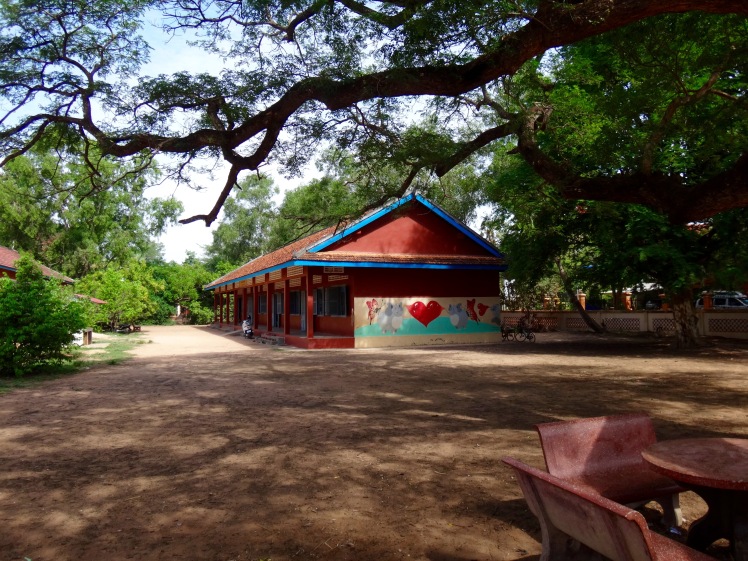
The average monthly income in Cambodia is about $100 USD, barely enough to make ends meet. Teachers earn about $150 USD per month, and often sell at the markets to supplement their income. Because of this low wage, teachers are inclined to accept bribes in exchange for passing marks in exams. One dollar can buy you an A on your final test. But the government eventually intervened on this covert practice, and success rates on exams plummeted to just 30%. The goal is to eventually raise the teaching salary to $250 per month, thus eliminating the need for second jobs, and granting the children a quality education.
As we meandered through the schoolyard, peeking into rooms from which excited little voices drifted, we saw that many were devoid of teachers. We stopped at one teacher-less classroom to watch a group of boys play soccer with an empty bottle up near the chalkboard. Other children peered at us through the windows and some grinned and waved hello. A woman rumbled into the yard on her motorbike, and the boys swiftly abandoned their game and sat primly on their benches — the teacher was back. She had been at the market.
The grade one classes were letting out just as we were leaving the school, and Sokha motioned towards a little girl riding past us on her bicycle. “We’ll see her later,” he said. “She’s going to the market to help her parents.”
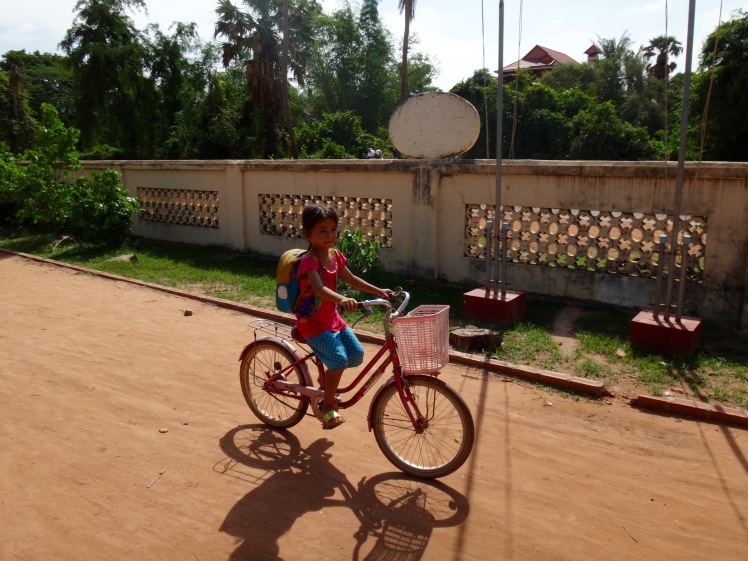
Nonthaburi Market Again?
I know you all looooved my post on Nonthaburi Market in Thailand, and I was fortunate enough to visit another just like it. This one was smaller and much more intimate, but no less grotesque. This time I manned up and took some serious pictures, so I think I’ll let those do most of the talking.
The first thing I saw was a young woman carving up a block of ice larger than she, using a rusty old hacksaw. With little refrigeration, drinks are usually placed in giant coolers around giant blocks of ice like this one. These blocks are also crushed up and dumped into dirty recycled buckets, which are then used at market stalls to put in smoothies or in your glass of water or as the base of your crushed ice dessert. I myself partook in a lot of rusty hacksawed, dirty bucket transported ice. Mm mm.
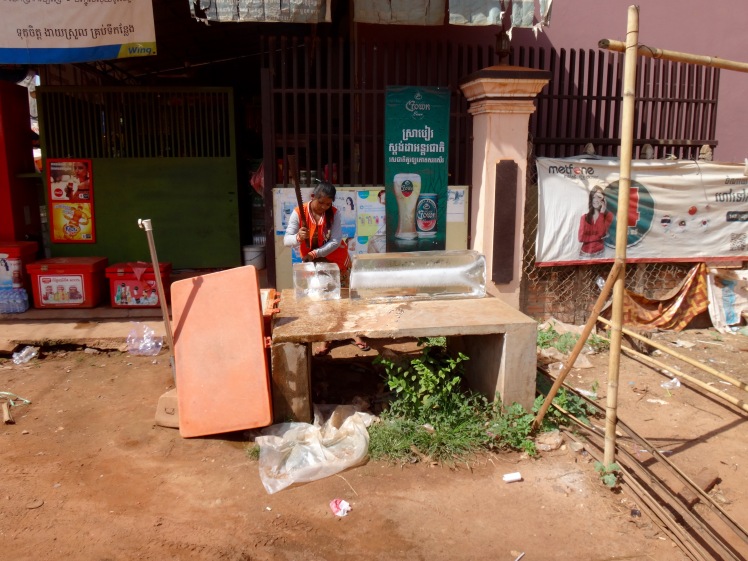
And then turning the corner onto the main market thoroughfare, it started as it always does, with fresh, vibrant green vegetables and juicy bundles of lychee and wafting durian aroma. We saw black jiggling blocks of grass jelly, buckets of palm sugar attracting flies, wriggling fish in metal tubs, ghostly pig faces with tails in their mouths. You know, all the market stuff. I was used to this by now so my face remained neutral and I surreptitiously snapped photos, answering questioning stares with big smiles. These are the fruits of my labour:
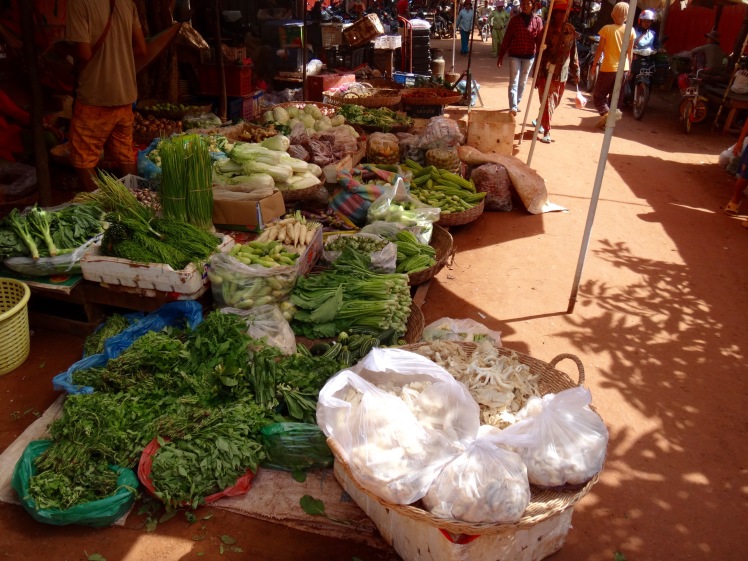
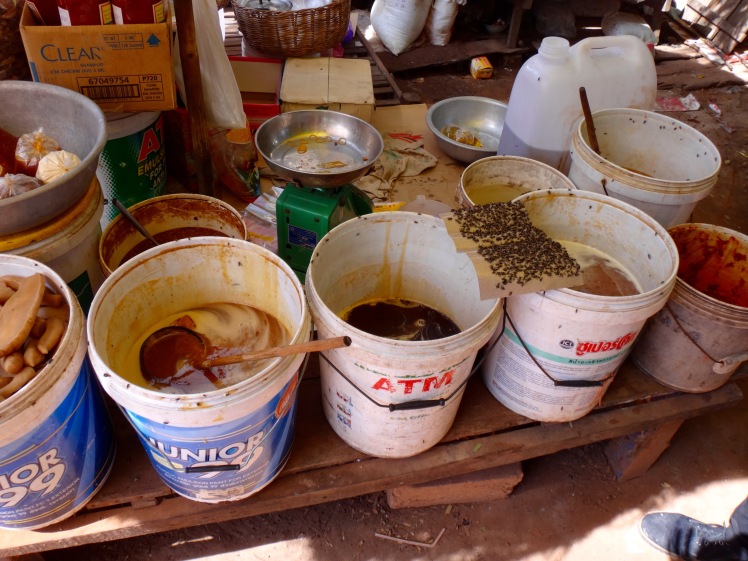
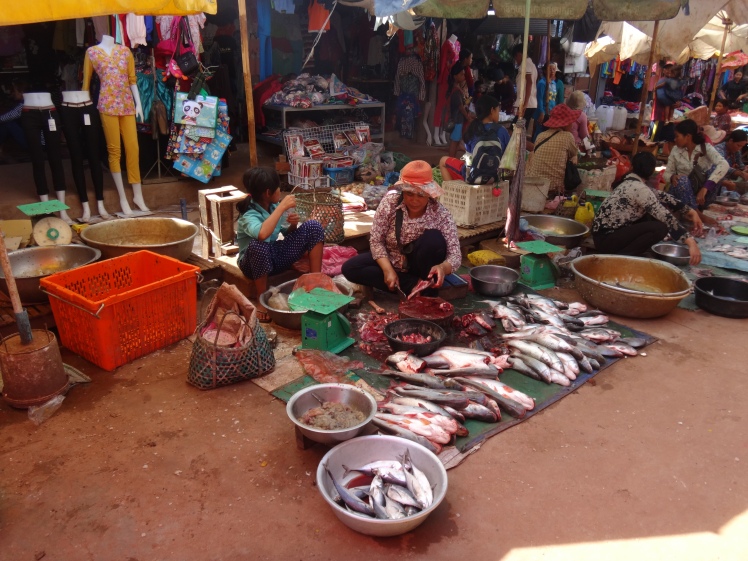
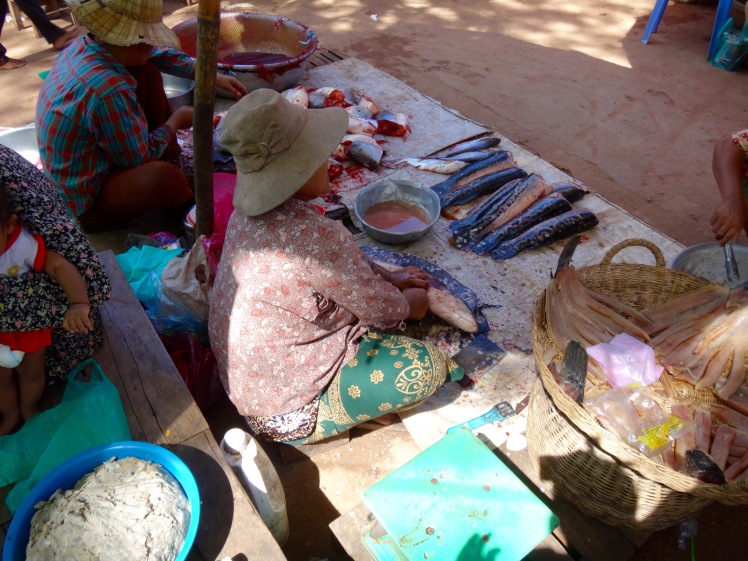
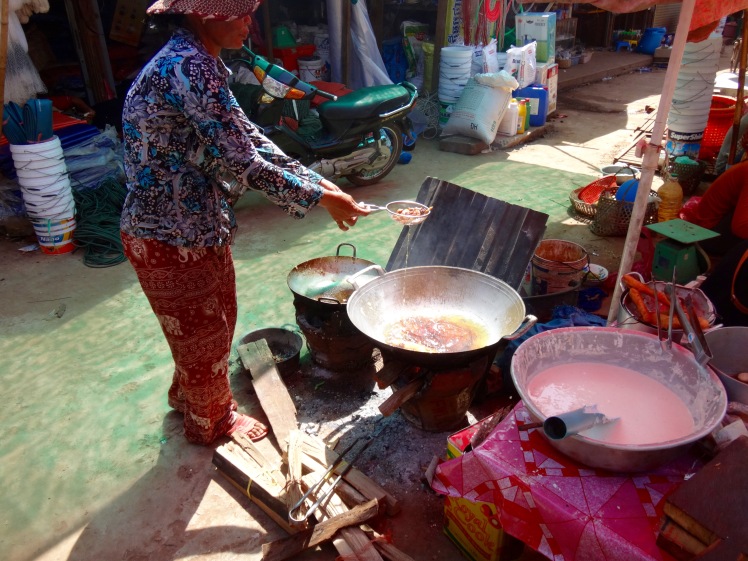
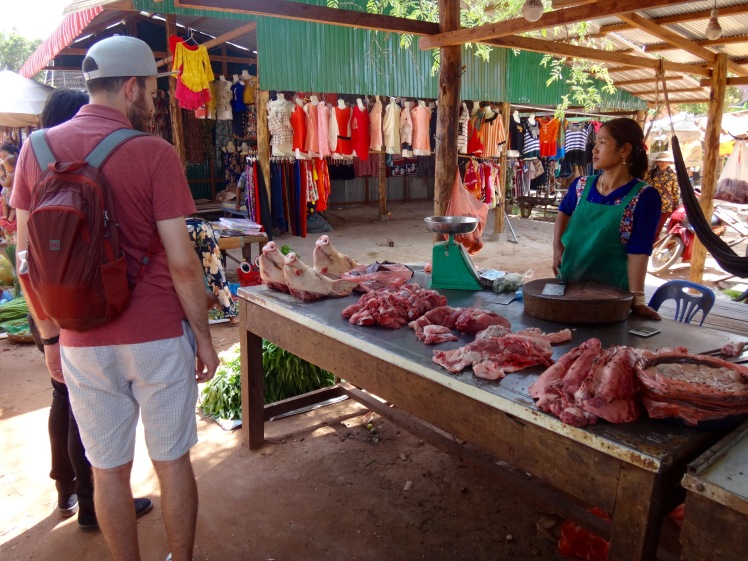
Kampong Khleang
After the market we drove to the outskirts of the floating fishing village Kampong Khleang. Our minibus careened through an impossibly narrow dirt road lined with houses on stilts, small fishing boats curiously sitting in their dry backyards. We veered sharply to avoid a herd of cattle leisurely crossing the road, who payed no attention to the cars and motorcycles that were forced to swerve or come to an abrupt stop. The further down the road we got, the taller the spindly stilts rose, some so tall that the front door was well over ten feet above your head. The day was hot and intensely humid and little clouds of red dust rose up behind every passing vehicle. Soon the traffic thinned and we were alone on the road, driving silently up the uneven path to the local house at which we were to have lunch.
We climbed up the steep wooden stairs into the home of Mrs. Sokha (yes, same name as our guide), who had just returned from a wedding party, wearing a long floral skirt and shimmery top. She spoke no English but gleefully held both my hands tightly in hers while saying somethin in Khmer, which I image was “what a beautiful young lady!” as grandmothers often say. We entered the simple but spotless living room: one small television in the corner, two hammocks suspended between posts, multiple pictures of Mrs. Sokha tacked to the walls. I noticed she was wearing the same floral skirt and shimmery top in each one.
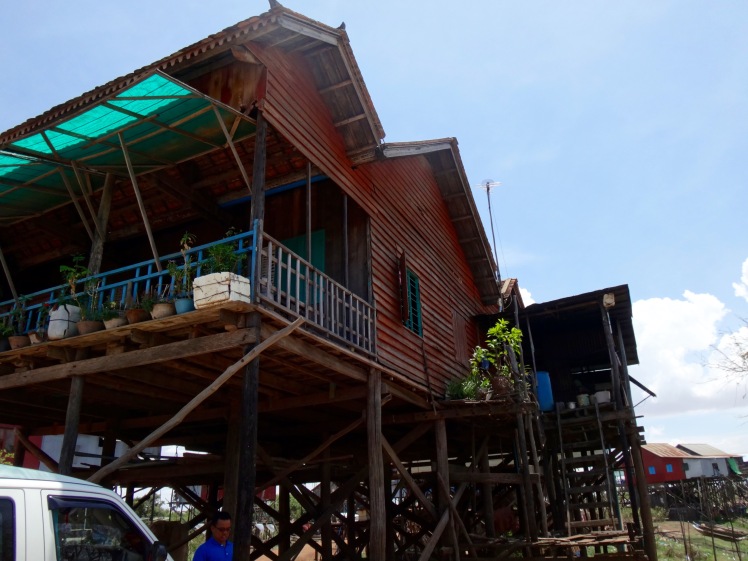
Our guide Sokha showed us pictures of the village during the wet season. The water was high enough to cover the stilts of all the houses, making it look like they were floating right on the surface of the water. Our whole bumpy, dusty car ride down a dirt road would have been a boat ride in the rainy season. That explained all the boats sitting in the grass. Can you imagine how much rain must fall to expand the area of the Tonle Sap lake to 12,000 square kilometres? When the rains come, the villagers switch from subsistence farming to fishing, adapting to their ever changing surroundings.
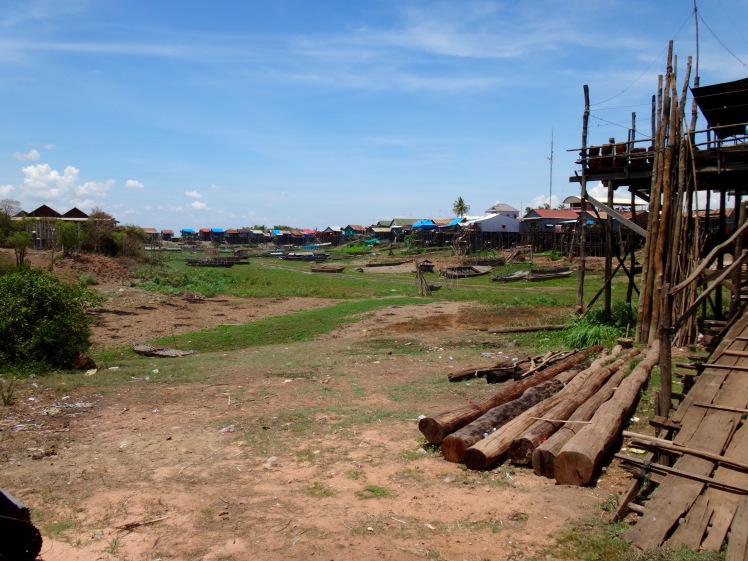
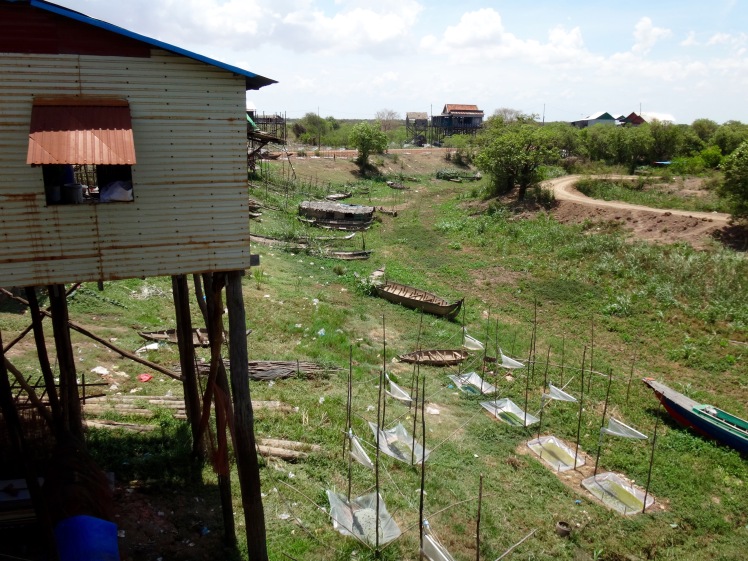
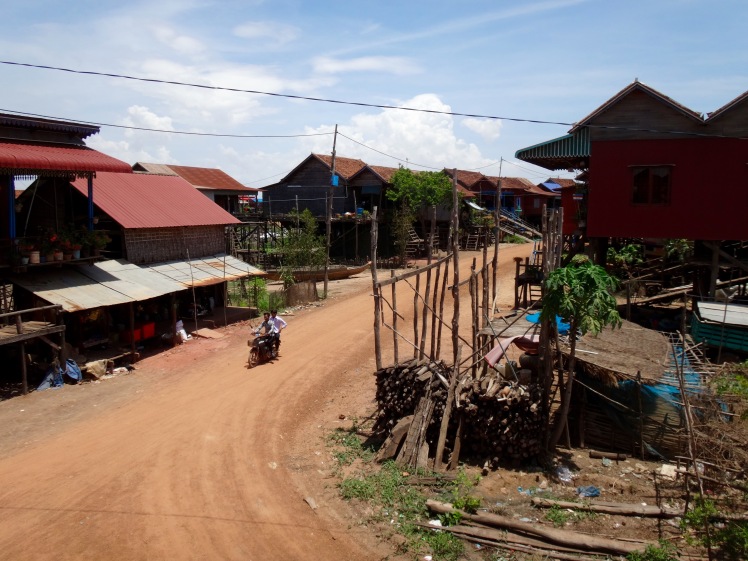
After lunch and a quick nap in Mrs. Sokha’s hammocks, we took a boat ride to a Vietnamese floating village where the homes actually are floating right on the surface of the water, held up by empty plastic barrels and inner tubes and other buoyant items. We began our journey to the village by catching a small motorboat from a dock that led onto what looked at first glance to be a mud puddle. It was just the end of the dry season, so water levels were at their very lowest, and this part of the Tonle Sap was reduced to a viscous brown sludge. We carefully tiptoed down the hazardous dock and into our boat, avoiding missing or loose slats along the way, breathing in a heavy stench of decaying fish and rotting garbage and whatever else lay under that mud.
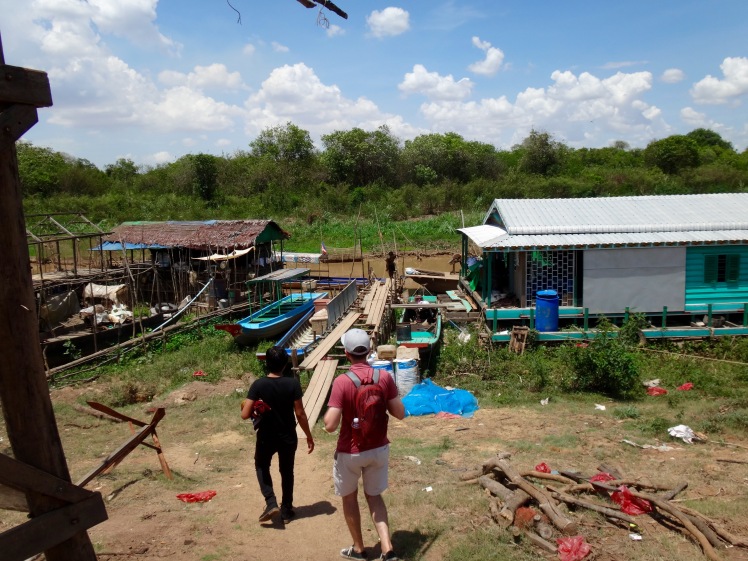
We rode for many minutes before the chocolate pudding water finally thinned into a more translucent brown, like a watery chocolate milk, but not before a passing boat neglected to slow its motor, splattering us in a healthy coating of thick river mud. And so we continued down the river, speckled in brown, passing floating homes with battery-powered satellite TV, floating fish farms, and even a Vietnamese school. I’m not too clear on how the Vietnamese ended up in Cambodia, but I think they live on the water because they’re technically not allowed to own land or something? I’m not sure. We floated through the immense village which would only expand as the waters rose; many houses were still on dry land on the banks of the lake, but were equipped to float.
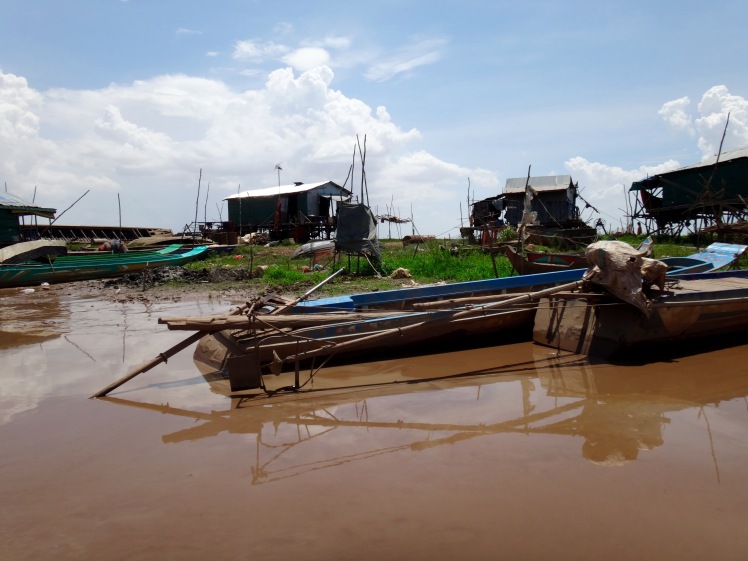
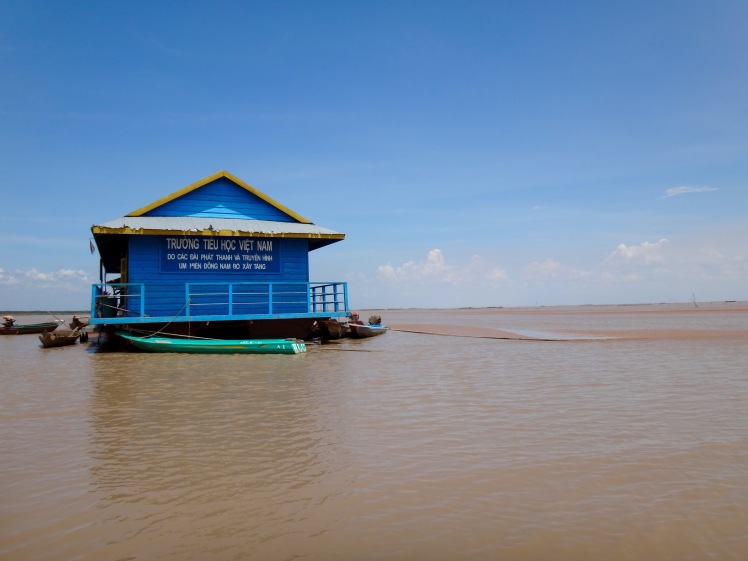
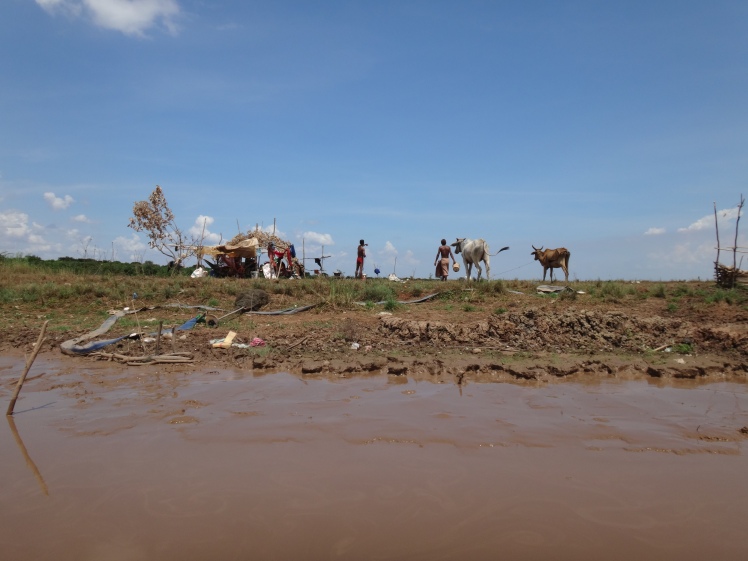
As we rode back to the dock my thoughts on this fascinating water life were interrupted by a grinding jolt as our boat ran up the bank of the lake and got wedged in the mud. Our driver (who looked to be about 12 years old) had gotten distracted and forgot to steer the boat. He hopped out and his bare feet squelched through the sucking mud as he pushed the boat back on course. Sokha told us our child driver probably should have been in school, but he makes about $50 per month by doing this job. I think we inadvertently supported child labour. Oops…
Sokha also told us (and we heard this from a few other locals as well) that the levels of the Tonle Sap have been drastically affected by the fact that China build a hydro electric dam across the Mekong which flows into Tonle Sap, and Laos has followed suit. The water levels have been a few meters lower on average each year, and if things continue in this fashion, many villagers could find themselves homeless and/or jobless.
And here I find myself at the end of yet another 3000 word post. Thank you again for reading, and thank you for your patience as you await the next tale in my adventures.
great post
LikeLike
Another enthralling post. I think you should have gone for the special, buy the head and get the tail. Lol!!!!
LikeLike
Hahahaha!
LikeLike
This is so sad 😦 I can’t begin to explain how delusional we westerners are. We are all victims of believing media and marketing and our politicians. We think everything is somewhat ok with the world and as long as turmoil and poverty and all that is bad is happening somewhere else, we are doing fine. We fail to realize that by not doing anything – not acting on it – we are condoning and in many ways prolonging and accepting what is going on. That is hard to accept 😦 btw…were those flies on those buckets?
LikeLike
Yup, very sad… And yes, those are lots and lots of flies.
Sent from my iPad
>
LikeLike
I’m not sure why we just opened a Bank in Cambodia given how you’ve described it.
LikeLike
I tried to post something here the other day, not sure if it went thru, but needless to say, this was another great read…we can all stand to think a bit more about the millions of people in the world who were simply unlucky enough to have been born where they were. The worst part of it is that most of these desperate situations are man made. Greed and corruption are such ugly beasts.
….and the rusty bucket transported ice sounds delish!😝
LikeLike
Yes I saw your previous comment! There is such ugliness in the world, you’re right. I’m glad you’ve been enjoying reading. Sorry I can’t do it often enough!
LikeLike
Tania it is horrible what some humans go through! It is good that you are aware, it puts things in perspective. Your writing is getting better and better. I think this blog should be a book when you are done. 🙂
LikeLike
Thanks dad! We’ll see about that book…
Sent from my iPad
>
LikeLike
Tania, congrats on your beautiful, descriptive informative blog. You certainly show a talent for writing.
You will both come back different people after seeing such a drastic look on life outside North America.
I must say, even though not to the same degree, the dynamics of life in Cambodia and Thailand has similarities of post war period in my birth village. My own father was analphabet, never went to school as he had to work the fields as a child, my grandfather made wooden shoes for my mother, large families would give up their children as servant to the rich. Reading your blog brings me memories of childhood, including maimed friend due to unexploded war bombs. I must commend you and Paul for having the courage to dive in other cultures and the passion to embrace it.
Keep blogging!
LikeLike
Thank you, papa! Thank you for reading and thank you so much for your lovely comments! It really is amazing to experience this up close and personal, and it helps us remember that people close to us like yourself, like our grandparents, have experienced a lot of this first hand. A lot of the past never quite goes away, and while those of our generation are content to forget, it sticks with the older generations. I feel like we’re paying homage to everyone that’s come before us.
LikeLike